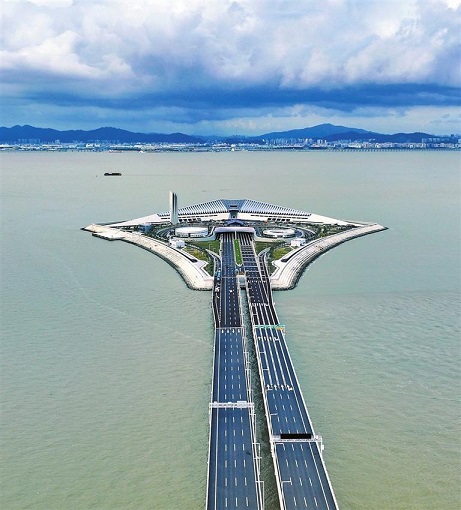Shenzhen
 2024/6/28
2024/6/28
 source: Shenzhen Daily
source: Shenzhen Daily
 Print
Print

A view of the Western Artificial Island on Thursday. It is one of the two artificial islands that are part of the Shenzhong Link, serving as crucial interchanges for bridge and tunnel traffic. Liu Xudong
Han Ximin
1824295095@qq.com
AFTER seven years of construction, the Shenzhong (Shenzhen-Zhongshan) Link, the mega cross-sea infrastructure project that connects cities on the eastern and western sides of the Pearl River Estuary, will open to traffic at 3 p.m. Sunday, according to an announcement Thursday.
An opening ceremony will be held Sunday morning. Upon opening, the travel time between Shenzhen and Zhongshan will be slashed to approximately 30 minutes from the previous two hours.
Located in the core area of the Guangdong-Hong Kong-Macao Greater Bay Area (GBA), the Shenzhong Link is about 30 kilometers south of the Humen Bridge and 31 kilometers north of the Hong Kong-Zhuhai-Macao Bridge.
The 24-kilometer link includes a 6.85-kilometer sea tunnel, a 17.2-kilometer above-sea bridge section, and two artificial islands.
It begins at the Shenzhen Airport Interchange, moves westward over the Lingdingyang sea area, connects to the Nanzhong (Nansha-Zhongshan) Highway through the Wanqingsha Interchange, and ends in Zhongshan City’s Ma’an Island, where it interfaces with the Zhongshan-Kaiping Highway.
For cars with no more than nine seats, the toll rate for a one-way trip across the entire link is 66 yuan (US$9.08). Specifically, the rate for the section between the Eastern Artificial Island and the Western Artificial Island is 27 yuan. The rate for traveling between the Western Artificial Island and the Wanqingsha Interchange is 23 yuan. Lastly, the rate between the Wanqingsha Interchange and the Hengmen Interchange is 6 yuan.
In April, the project was awarded the George Richardson Award by the International Bridge Conference and named one of 50 iconic projects in the global tunnel and underground engineering field by the International Tunneling Association.
As a step in advancing the infrastructural development of the GBA, the project will connect Guangdong’s three up-and-coming free trade zones of Qianhai in Shenzhen, Nansha in Guangzhou, and Hengqin in Zhuhai. It will also connect the Guangzhou-Shenzhen-Hong Kong Science and Technology Innovation Corridor and the Guangzhou-Zhuhai-Macao Science and Technology Innovation Corridor.
It will further facilitate the flow of key elements, such as technology, talent, and capital, within the GBA and fuel the engine of new productive forces.





